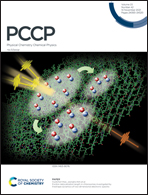Two-dimensional FeTe2 and predicted Janus FeXS (X: Te and Se) monolayers with intrinsic half-metallic character: tunable electronic and magnetic properties via strain and electric field†
Abstract
Driven by the fabrication of bulk and monolayer FeTe2 (ACS Nano, 2020, 14, 11473–11481), we explore the lattice, dynamic stability, electronic and magnetic properties of FeTeS and FeSeS Janus monolayers using density functional theory calculations. The obtained results validate the dynamic and thermal stability of the FeTeS and FeSeS Janus monolayers examined. The electronic structure shows that the FeTe2 bulk yields a total magnetization higher than the FeTe2 monolayer. FeTeS and FeSeS are categorized as ferromagnetic metals due to their bands crossing the Fermi level. So, they can be a good candidate material for spin filter applications. The biaxial compressive strain on the FeTe2 monolayer tunes the bandgap of the spin-down channel in the half-metal phase. By contrast, for FeTeS, the biaxial strain transforms the ferromagnetic metal into a half-metal. The electric field applied to the FeSeS monolayer in a parallel direction transforms the half-metal to a ferromagnetic metal by closing the gap in the spin-down channel.



 Please wait while we load your content...
Please wait while we load your content...